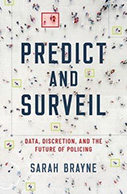Predict And Surveil: Data, Discretion, And The Future Of Policing

Author: Sarah Brayne
Publisher: New York: Oxford University Press. 2020. 224p.
Reviewer: Thomas L. Scott | May 2021
At the risk of sounding banal, Sarah Brayne’s research on big data analytics in policing could not be timelier. During the year 2020, violent crime increased by historic proportions in many large cities, arrest rates dropped to near historic lows, and civil unrest resulted in great costs to communities. These issues are likely to continue in 2021 as evidenced by the acts of domestic terrorism that occurred at the U.S. Capitol Building on January 6, and the failed police response. Calls for reforms to law enforcement at the local level in 2020 and the federal level at the start of 2021 demonstrate the shortcomings of current policing practices, and the immediate need for research on new, innovative law enforcement practices. Big data analytics, when applied to policing strategies and tactics, is one innovative tool that could answer calls for police reform by increasing the efficacy, efficiency, and fairness of the police. In Predict and Surveil, Brayne documents this potential, but ultimately decides that big data analytics and its associated surveillance and data collection activities ultimately increase inequalities in the application of law enforcement. To this reviewer, although Brayne raises important points and provides support for the advantages and disadvantages of big data analytics, her book falls short of providing sufficient evidence that the disadvantages of big data analytics and its predictive algorithms outweigh the inefficacies, inefficiencies, and inequities in current and historic law enforcement practices and decision-making.
Brayne defines big data as “a data environment made possible by the mass digitization of information and associated with the use of advanced analytics, including network analysis and machine learning algorithms.” To understand how big data has been received by law enforcement and to determine its effect on the institution, Brayne embedded herself in the Los Angeles Police Department (LAPD) for two and a half years to conduct intense qualitative research. She had near unprecedented access to the LAPD through interviews, ride-alongs in cars and a helicopter, shadowing, and interactions with officers and civilian employees after hours during lunch, at bars, and at coffee shops. The extent of access Brayne had to employees in the LAPD, as well as employees in the Los Angeles Sheriff’s Department and the nearby federal fusion center is incredibly rare for a researcher. The rich data collected from Brayne’s research design makes Predict and Surveil an important contribution to research on police operations, management, and culture. Unfortunately, Brayne would not provide details of how she obtained her access to the department, other than saying that she obtained support from an individual at the top of the organizational hierarchy. It is well known by police researchers that, because of the rigid chain of command in law enforcement agencies, the best way to gain a department’s participation in research is to get buy-in from the top. It would have been a nice addition to the book if the author had been willing to describe in detail how she so effectively gained access to the LAPD and the fusion center.
Although Brayne’s view of big data analytics in policing lies on the border of suspicion and admonishment, much of the evidence presented in the book points to its ability to actually improve law enforcement practices. The book starts with a compelling example of how the use of an automatic license plate reader, vehicle registration data, and a gang database allowed the LAPD to solve a murder within 48 hours. Without these technological tools and data systems, this investigation could have taken months of detective overtime and police resources. During this time, the offender would have remained in the community free to commit additional violent crimes. Throughout the book, law enforcement employee anecdotes provide ample evidence of how big data analytics can improve law enforcement’s ability to prevent and solve crime. Brayne also cites randomized controlled trials that demonstrate that predictive policing can improve officer decision-making. Importantly, Brayne makes thoughtful points about the negative effects of big data analytics on police accountability, resident surveillance by law enforcement, system avoidance by residents under surveillance, and citizen legal protections. She does not, however, provide evidence to support her claim that existing (i.e., not big data) police practices result in different or better outcomes than those achieved using big data and its predictive algorithms. For example, the author’s primary criticisms of big data analytics in law enforcement are that it 1) deepens police surveillance of crime suspects; 2) increases surveillance of the general public; 3) leads to unequal surveillance of persons and places; and 4) results in system avoidance. Although big data analytics appears to do each of these things, the author never proves that these practices increase police bias and resident inequalities more than the counterfactual, business as usual approach. Under that approach, law enforcement officers still target specific persons, groups, and places, and research shows this targeting is associated with system avoidance. Additionally, officers still collect information that they believe is related to crime proneness, but do so less formally and transparently (e.g., in their head as opposed to on paper) and using less well-defined and evidence-based measures (e.g., race as opposed to criminal history). Finally, Brayne did an excellent job portraying how big data analytics and Operation LASER greatly increased both the amount of data collected by the LAPD and the types of people on whom data were collected. These discussions reveal how innovations can change the culture and function of law enforcement (e.g., changing the function from law enforcement to data collection) and how that change can vary greatly within a single department. These are important findings for future research on policing. Still, there was not a convincing explanation of how formalizing and expanding data collection increases inequalities beyond those that exist in current policing practices, and it seems to have the potential to aid in the identification of co-offenders and offender networks that can be leveraged for crime control, which would make law enforcement more effective and efficient.
The majority of Predict and Surveil is dedicated to examining the LAPD’s use of big data analytics for resident surveillance and law enforcement. Chapter Five changes the focus to the use of big data by the LAPD for the surveillance and management of officers. Brayne explains the importance of this chapter by stating, “[u]nderstanding patterns of contestation with regard to big data analytics helps us understand how new practices are adopted, resisted, and deployed. It also helps us understand professional identities, roles, and interactions within the deeper patterns of organizational change and continuity.” I found this chapter to be the most compelling chapter in the book. The reason for this is that Brayne was best able to answer her important research questions on police job satisfaction, management, and culture. Her method of interviewing employees, sometimes casually as an embedded sociologist, is an excellent research design to get detailed and honest responses to improve our understanding of these phenomena. The author obtained detailed views from sworn officers, civilians, and police leaders about the collection and use of data on officer behavior and the methods that managers use to effectively convince officers of the value of data-driven policing. Brayne also gained an understanding of how big data analytics can change organizational dynamics including promotion decisions and levels of trust between managers and front-line workers. These topics can be challenging to study using other research designs like surveys, so Brayne’s unique access inside the LAPD stands out as an outstanding accomplishment in research. I would highly recommend that educators incorporate this chapter into their lessons on police management, culture, and technology.
In her concluding chapter, the author reiterates that big data analytics is not the objective decision-making tool that many claim it to be. Instead, it simply replaces discretion used by police officers, supervisors, and leadership to third-party, private companies who make discretionary choices on which measures to collect, and which measures to include in prediction models. Yet, these discretionary choices seem to be based on data and evidence to a greater extent than the discretionary choices of law enforcement professionals in the current era of policing. Additionally, the competitive marketplace in which these firms operate provides a stronger incentive to build products that best predict crime and most prevent company risk as opposed to the current incentives found in the public sector of law enforcement. In sum, although Brayne raises many important points about what big data analytics are and are not, she does not answer the important question of whether these improve or worsen current policing practices. Also, in this chapter, Brayne concludes that the responsibility should be on law enforcement to justify the use of big data and new surveillance tools prior to implementation. Although this is a good goal to set, the same underacknowledged issue arises that has persisted throughout the book — the current system of law enforcement is badly flawed. The baseline is an unacceptable status quo in which to endure delays in the implementation of promising, evidence-based policing methods. The author did not convincingly demonstrate that big data analytics result in worse outcomes than policing that is conducted by departments that do not use big data and predictive algorithms for law enforcement.
In summary, Sarah Brayne’s Predict and Surveil presents results from a rare and rigorous research design that allowed her to collect detailed data from a range of law enforcement and surveillance professionals on the use, success, and ramifications of big data analytics in policing. Tools like automatic license plate readers, facial recognition software, and data driven algorithms are likely to increase the proportion of crimes that the police prevent and solve while decreasing the costs involved in law enforcement. The increased effectiveness and efficiency of the police benefits residents. Big data can also be used by supervisors to assess officer risk and performance, which might result in higher quality police forces. Yet, big data analytics are imperfect and have the potential to exacerbate existing societal inequities while appearing to ameliorate them. Despite the lack of evidence showing that the adoption of big data analytics results in better or worse outcomes than those found in current policing practices, Brayne’s attention to critical issues surrounding the adoption and use of big data in law enforcement should be essential reading for law enforcement and city leaders who are weighing the benefits and costs of implementing big data and surveillance technology for crime prevention and/or officer management.
Thomas L. Scott, Social Scientist, Policing Research Program, RTI International


